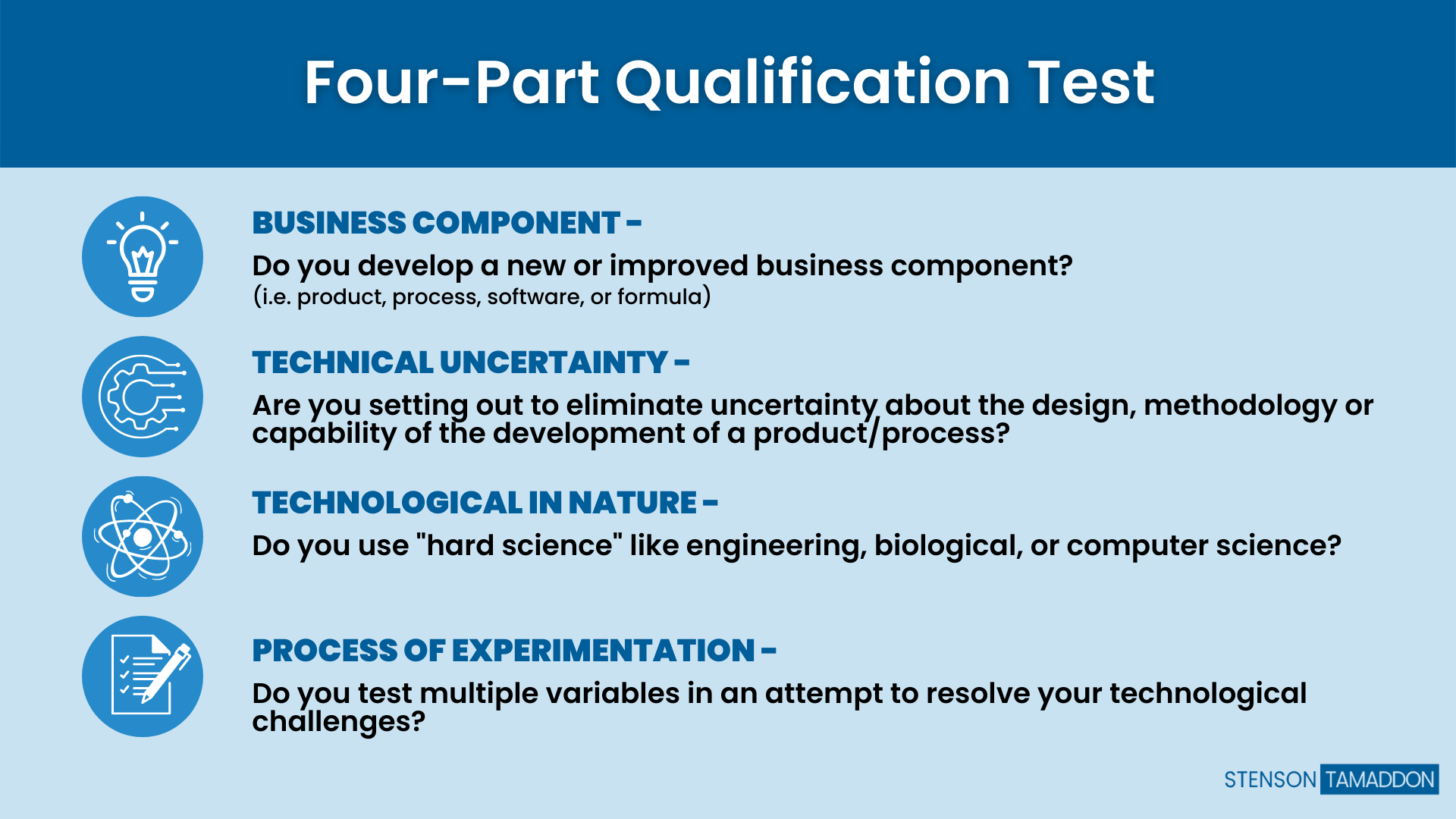Research & Development Tax Credit: The Basics for Employers
There are a lot of questions surrounding the Research & Development (R&D) tax credit. What is it? How did R&D credits get started? Which research and development projects qualify? If I have employees who handle specific related tasks, could I qualify? How do I get started? Is there a way I can be sure I’m filing for R&D credits correctly? But for most small business owners, the time it takes to research each of these questions can be daunting. So today, we’re tackling each of these questions and getting you the answers you need.
What is the R&D Tax Credit?
The R&D tax credit, also known as Research and Experimentation (R&E) tax credit , is a United States government-sponsored tax initiative. It results in a dollar-for-dollar reduction in a company’s tax liabilities and is one of the best things American businesses can do to reduce their liability tax.
The research and experimentation tax credit was essentially designed as an incentive to make research activities more affordable for businesses, strengthening American innovation.
The History Behind the R&D Tax Credit
Initially, the R&D tax credit was created in 1981 by U.S. Representative Jack Kemp and U.S. Senator William Roth. It has since expired eight times and been extended 15 times. It was made during a perceived economic slowdown and job outsourcing to protect Americans, encourage investment in development, and increase research activities and basic research payments.
When the credit first rolled out, to qualify, a company had to design or produce a novel product or technique according to what was referred to as the “Discovery Rule.” Unfortunately, this meant that only a few cutting-edge businesses were eligible.
In 2003, regulations were added to eliminate the “Discovery Rule” and expand which activities could qualify for small businesses to claim the R&D credit. Instead of being “new to the world,” activities could now be “new to the taxpayer,” increasing the number of small businesses that could qualify.
Three years later, the Alternative Simplified Credit (ASC) was instituted and provided added flexibility with updated baseline calculations for the credit. In 2013, provisions were added to allow ASC for amended returns for years that a taxpayer did not previously claim the credit.
Thirty-four years after the R&D credit was created, the Protecting Americans from Tax Hikes Act (PATH Act) was passed. This milestone document officially made the Research & Development tax credit a permanent addition to the U.S. tax code. Also, in 2015, new regulations were added to allow businesses grossing less than $50 million in tax receipts to claim the credit.
During the latest batch of updates, in 2018, Alternative Minimum Tax (AMT) restrictions were loosened to allow S-corps and C-corps to apply for the R&D credit. Today, Research & Development tax credits remain one of the most remunerative tax incentives for small businesses.
Who is Eligible for the R&D Tax Credit?
Many businesses are not aware if they actually meet eligibility qualifications. Some believe there are special rules needed to qualify. While the correct documentation is required, in reality, over 60 industries can qualify for R&D credit in over 30 states to offset tax liabilities. Some businesses’ daily operations can be eligible for them, allowing them to receive basic research credit if it puts them over a certain base amount. Even startups can use this to their advantage.
If your company spends money on improving or developing processes that apply to a field of science, you may be eligible to claim the Research & Development tax credit. This can be as simple as dedicating money to refining your company’s manufacturing process, hiring someone to increase efficiency within your company, etc.
Your small business could qualify for R&D tax credits if you manage the following types of employees:
- Engineers, including manufacturing, product, process, software, design, and test
- Technicians, including assembly, CAD, and engineer
- Operators, including CNC and plant
- Designers
- Drafters
- Fabricators
- Machinists
Additionally, if your small business is handling these types of projects, you too may qualify:
- Creating new or innovative products
- Updating existing products
- Building new processes, techniques, or prototypes
- Developing more efficient software
- Hiring contractual engineers or designers to research or complete research projects
But what about sole proprietor small businesses? A recent Statista Research Department report shows over 27.1 million non-employers (sole proprietors). And what’s still, the number of non-employers has been demonstrated in this research report to be growing more rapidly than employer firms. While many entrepreneurs launch their businesses as sole proprietorships, they may think they’re not eligible to apply for an R&D credit. But non-employers can still qualify to take the credit at the federal level. The limits are the same no matter the number of employees, but as a qualified startup, you can take the credit to offset payroll taxes instead of income taxes.
Are you still unsure if you qualify for the R&D credit? The IRS has outlined a four-part test to determine eligibility for your small business. If you can checkmark the below tasks and aren’t taking advantage, you could miss out on thousands to reduce your tax liabilities.
Can You Pass the Four-part Qualification Test for R&D Credits?
The IRS has outlined a four-part test to determine eligibility for your small business. If you pass these tests and aren’t taking advantage, you could be missing out on thousands to reduce your tax liabilities.

According to the IRS, creating or innovative new products or processes are known as qualified research activities. The amounts incurred or paid during the research activities, such as employee wages and supply costs, are known as qualified research expenses.
Incorporating basic research activities in your small business strengthens American innovation and makes them more affordable. What’s more, you’ll be maximizing available tax credits while prioritizing compliance.
How to Take Advantage of the R&D Tax Credit
You’re ready to lace up your track shoes to hit the ground running to take advantage of the R&D credit, but then this thought occurs. “How on earth do I get started?” We hear you. This section outlines the first steps you’ll need to begin filing for a Research & Development tax credit. So get ready: You’re about to take steps toward attaining a dollar-for-dollar reduction in your company’s tax liabilities.
Step 1: Find out if you could be eligible. Did you pass the IRS four-part test, or could you relate to any of the instances in that same section above? If so, there’s a great chance you could already be qualified. So move right on to step 2! Still not sure? Connect with one of our tax specialists , and they’ll be able to work with you to see if you may be eligible.
Step 2: Gather necessary documentation. The IRS requires ample documentation to prove the qualified activities were performed and support the attached expenses claimed for the Research & Development credit.
Examples of these R&D documents could include:
- Payroll records (especially wages paid specifically for R&D projects)
- Chart of accounts for the general ledger
- Lists of all supplies used in Qualified Restoration Expenses (QREs)
- Organizational charts
- Contract copies with contractual work and vendors related to QREs
Namely, you’ll want to be sure to retain all records that relate to and track the research and development projects, especially the calculations of the credit eligibility.
Step 3: Fill out a quick 7-question form to get started filing. When filing for a Research & Development credit, it’s normal to have questions, especially when tax hikes are in full swing. But if you’re ready to start the process right the first time , we’re here to help. At Stenson Tamaddon, we’re a compliance-driven, technology-enabled, and customer-first company. We believe in a professional, compliant approach to tax credit services and provide a hassle-free promise to customers that their R&D Tax Credit filing will always be accurate, compliant-focused, and secure.
Step 4: Use our proprietary technology to securely upload all your R&D documents and information to our tax credit team. Our unique tax credit-focused technology supports your success by maximizing ROI, prioritizing compliance, and offering audit-ready solutions. With offices from New York to Arizona, we exist to deliver optimal results for your R&D Tax Credit filing with minimal disruption to your business.
Step 5: We’ll take your information, prepare it and submit it for filing with the IRS with our 100% secure and compliance-focused technology. Our tax specialists guarantee that your experience will be professional, timely, and compliance-driven, saving you time, money, and resources. The best part? We’ll ensure that while you’re filling for the R&D Tax Credit, you’re not missing out on other tax credit filings you may be eligible for.
Partnering with Stenson Tamaddon is the best thing you can do when filing for an R&D tax credit to ensure all is done to keep you in compliance and maximize your overall return – and that’s why we’re here! We’ll look at your expenditures, base amount, tax rate, contract research, and gross receipts in all open tax years to determine how much R&D credit you qualify for so your small business can receive its basic research credit.
Apply to file for your Research & Development tax credit today. Set your business up for success with Stenson Tamaddon.
The post Research & Development Tax Credit: The Basics for Employers first appeared on Stentam.
The post Research & Development Tax Credit: The Basics for Employers appeared first on Stentam.




Lead Types
ERC Exclusive Leads
ERC Inbound Calls
ERC Small Business Data
Our Company
Let’s Connect
Youtube
Contact Us
GetErcLeads.com is Powered By GROW with MKG


